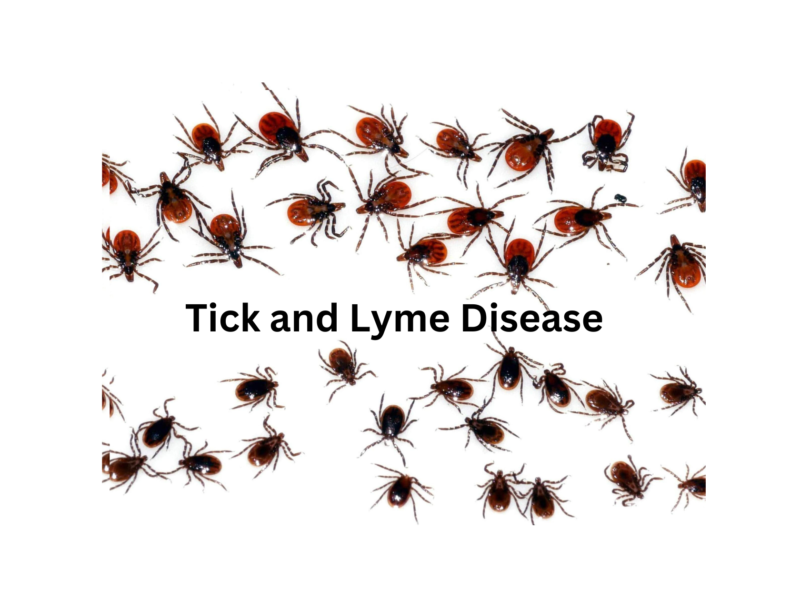With the arrival of warmer weather, many of us are eager to explore the great outdoors. However, it’s important to be aware of potential health risks, and one such concern is tick-borne diseases, with Lyme disease being the most prevalent. In the following article, we’ll explore into the world of ticks and Lyme disease, shedding light on the dangers they pose and offering useful advice for safeguarding yourself and those close to you.
Understanding Ticks and Lyme Disease
Ticks are tiny arachnids that consume both human and animal blood as food. They can often be spotted in forested regions and areas with tall grass, and bushes, making them prevalent in outdoor recreational areas. While ticks themselves are not dangerous, they can transmit various diseases, with Lyme disease being the most notorious.
Lyme disease is caused by the bacterium Borrelia burgdorferi and is It is typically spread through the bite of ticks that are infected, specifically those known as deer ticks or black-legged ticks. These ticks are typically found in heavily wooded and grassy areas, particularly in regions with high deer populations.
Recognizing the Symptoms of Tick and Lyme Disease
It is essential to recognize the symptoms of both tick bites and Lyme disease to seek prompt medical attention. Here are the symptoms associated with tick bites and Lyme disease:
1. Erythema migrans (EM) rash
This is the most characteristic around 70-80% of cases of Lyme disease display this symptom. The EM rash typically appears as a circular or oval-shaped red rash with a clear center resembling a bullseye. It may expand over time and usually appears between 3 and 30 days following a tick bite.
2. Flu-like symptoms
During the initial phases of Lyme disease, individuals might undergo symptoms similar to the flu, including tiredness, elevated body temperature, head pain, discomfort in muscles and joints, and enlarged lymph nodes. These symptoms are often mild and may be overlooked or mistaken for other illnesses.
3. Neurological symptoms
If Lyme disease is left untreated or not properly treated, it can progress and affect the nervous system. Neurological symptoms may include severe headaches, stiffness of the neck, facial paralysis (Bell’s palsy), numbness or tingling in the extremities, memory problems, and difficulty concentrating.
4. Joint pain and swelling
Lyme disease has the potential to trigger joint inflammation, resulting in discomfort, enlargement, and rigidity. It most commonly affects large joints, such as the knees, but can also involve other joints.
5. Heart problems
In rare cases, Lyme disease can affect the heart, leading to irregular heart rhythms, chest pain, and shortness of breath.
Treatment of Tick and Lyme Disease
Managing tick bites and addressing Lyme disease involves different approaches depending on the specific situation. Here are the general principles of treatment for tick bites and Lyme disease:
1. Tick Bite Treatment
If you have been bitten by a tick, here are the steps to follow:
a) Remove the tick
Grab the tick as closely to the skin’s surface as you can with fine-tipped tweezers. Gently pull upward with steady pressure, avoiding twisting or crushing the tick. After taking it off, cleanse the bitten area using soap and water.
b) Monitor for symptoms
Monitor the area where you were bitten for any indications of an allergic response or infection. If you experience symptoms such as rash, fever, or flu-like symptoms, seek medical advice.
2. Lyme Disease Treatment
Antibiotics are frequently used to treat Lyme disease to get rid of the infection. The specific The treatment strategy could differ based on the disease stage and the extent of symptom severity. Here’s an overview:
a) Early-stage Lyme disease (Localized or early disseminated)
When Lyme disease is detected during its initial phases, oral antibiotics are usually prescribed. Commonly used antibiotics include doxycycline, amoxicillin, or cefuroxime axetil. The duration of treatment is typically 10 to 21 days, depending on the specific antibiotic prescribed.
b) Late-stage Lyme disease (Late disseminated)
If Lyme disease has progressed to a later stage or if symptoms persist despite initial treatment, a longer course of antibiotics may be necessary. Administering antibiotics through a vein, like ceftriaxone or penicillin, are often administered for 2 to 4 weeks.
c) Post-treatment Lyme disease syndrome (PTLDS)
Some individuals may experience lingering symptoms even after completing the recommended antibiotic treatment. This disorder is known as post-treatment Lyme disease syndrome (PTLDS). The management of PTLDS focuses on symptom relief and supportive care, such as pain management and physical therapy.
It is important to note that treatment decisions should be made in consultation with a healthcare professional experienced in managing Lyme disease. The selection of antibiotics and the length of treatment may differ depending on individual aspects, including age, overall well-being, and the existence of additional medical issues.
In addition to antibiotic treatment, it is essential to manage symptoms and support overall health during the recovery process. This may include rest, pain relievers, anti-inflammatory medications, and maintaining a healthy lifestyle.
Prevention Measures Against Tick and Lyme Disease
Key to safeguarding yourself is prevention against tick bites and reducing the risk of Lyme disease. Here are some crucial precautions you can take:
1. Avoid tick-infested areas
When possible, steer clear of areas known to have high tick populations, such as heavily wooded or grassy areas. If you need to venture into these areas, try to stay in the center of the trails and avoid brushing against vegetation.
2. Dress appropriately
When in tick-prone environments, make sure to don appropriate protective attire while spending time outside to minimize skin exposure. Consider the following clothing tips:
- Opt for light-colored long sleeves and pants to wear to make ticks more visible.
- To establish a barrier, tuck your jeans into your socks or boots.
- Choose closed-toe shoes or boots to prevent ticks from reaching your feet.
3. Apply insect repellents:
Use tick-repellent insect repellents that have been approved by the Environmental Protection Agency (EPA). Search for goods with the following active components:
- DEET: N,N-Diethyl-meta-toluamide
- Picaridin (also known as KBR 3023, Bayrepel, and icaridin)
- IR3535 (3-[N-Butyl-N-acetyl]-amino propionic acid ethyl ester)
- Oil of lemon eucalyptus (OLE) or para-menthane-diol (PMD)
Make sure to adhere to the guidelines provided on the product label at all times, and reapply repellent as needed, especially if you’re sweating or spending an extended period outdoors.
4. Treat clothing and gear with permethrin
Permethrin is an insecticide that can be sprayed on clothing, shoes, and outdoor gear to repel and kill ticks on contact. Permethrin-treated clothing remains protective after multiple washes.
5. Perform regular tick checks
After being outside, properly check your body for ticks. Pay close attention to areas such as the scalp, hairline, behind the ears, under the arms, around the waistline, groin area, and behind the knees. Promptly remove any ticks you find using fine-tipped tweezers, grasping the tick close to the skin’s surface, and pulling upward with steady pressure.
6. Create a tick-safe environment
Make your outdoor living spaces less appealing to ticks by implementing the following measures:
-
- Keep your lawn well-maintained, mowed short, and free from decaying plant matter on the ground.
- Remove dense tall grass and undergrowth from the vicinity of your residence and recreational areas.
- Establish a separation between your yard and wooded areas using wood chips or gravel.
- Keep playground equipment, patios, and play areas away from vegetation.
- Remove leaf litter, woodpiles, and debris from your yard.
7. Protect pets
Ticks can present a danger to your beloved furry companions as well. Utilize tick preventatives as advised by your veterinarian and regularly check your pets for ticks after they’ve been outside.
8. Be aware of peak tick season
Ticks are most active during warm months, typically from April to September. However, it’s important to remain vigilant year-round, especially in regions where ticks can be active even in colder seasons.
Seeking Medical Care
If you have concerns that you might have been bitten by a tick or are showing signs indicative of Lyme disease, it’s crucial to seek medical attention promptly. Your healthcare provider will evaluate your symptoms, perform tests if necessary, and prescribe appropriate treatment, typically antibiotics.
Conclusion
In conclusion, while ticks and Lyme disease pose a potential health threat, staying informed and taking preventive measures can significantly reduce your risk. By adopting the precautions mentioned above and promptly seeking medical care when needed, you can enjoy the great outdoors while safeguarding your health and well-being.
Keep in mind, safety hinges on prevention from tick-borne diseases. Stay vigilant, be proactive, and enjoy your time in nature while keeping the risks at bay.






